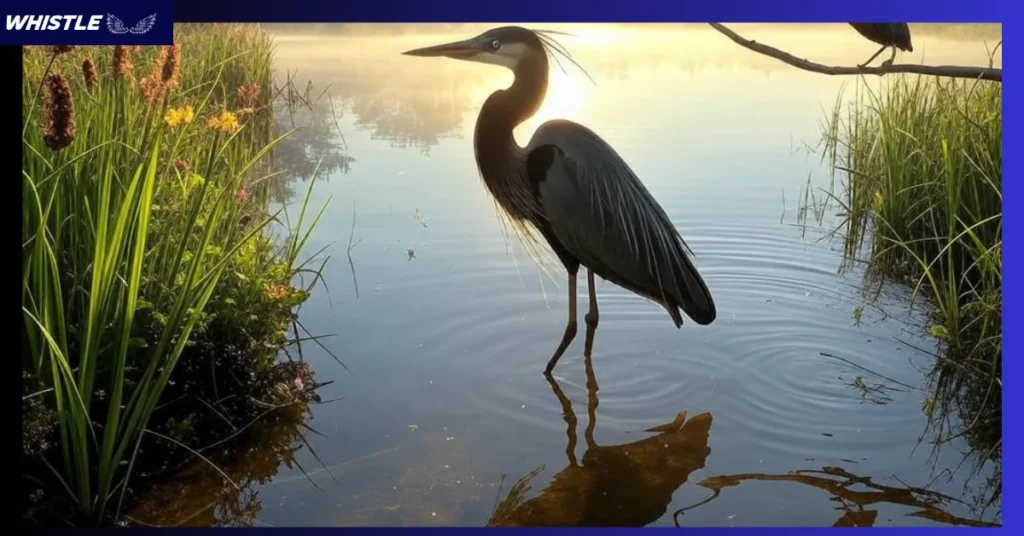Have you ever seen a graceful bird wading in Michigan’s wetlands and wondered what it was? Herons in Michigan enchant birdwatchers with their elegance and diversity.
From the towering Great Blue Heron to the elusive Black-crowned Night-Heron, we cover habitats, behaviors, sounds, and more.
This guide explores the eight heron and egret species found in the Great Lakes State. You’ll learn how to identify them, where to find them, and what makes each unique. Let’s dive into the world of Michigan’s herons.
Why Michigan Is a Haven for Herons?
Michigan’s vast wetlands, lakes, and rivers create a perfect home for herons. These birds thrive in diverse ecosystems, from quiet marshes to suburban ponds. Their long legs and sharp bills make them skilled hunters of fish, insects, and small mammals.

Most herons migrate south for winter, but some, like the Great Blue Heron, stay if open water remains. Knowing their habitats helps you spot these birds.
Key Habitats for Herons of Michigan:
- Wetlands and Marshes: Ideal for Green Herons and Least Bitterns.
- Lakeshores and Ponds: Great Blue Herons and Great Egrets frequent these areas.
- Rivers and Creeks: Little Blue Herons may appear along slow-moving waters.
- Agricultural Fields: Cattle Egrets forage near grazing livestock.
Great Blue Heron: Michigan’s Majestic Giant
The Great Blue Heron stands tall as Michigan’s largest heron. Its blue-gray plumage and S-shaped neck make it unmistakable. This bird adapts to various habitats, from rural marshes to urban ponds. It hunts by standing still or wading slowly, striking prey with speed. Great Blue Herons nest in colonies called heronries, often high in trees.
Identification Features:
- Size: 38–54 inches tall, wingspan 65–79 inches.
- Color: Blue-gray body, white face, black stripe over the eye.
- Flight: Neck tucked in, long legs trailing.
- Sound: Harsh “frahnk” or squawk, often heard when startled.
Where to Spot Great Blue Herons:
Look along the Chippewa River or at the Maple River State Game Area. Stony Island’s heronry on the Detroit River hosts over 140 nests, making it a prime spot. Visit in spring to see nesting behavior.
Fun Fact:
Great Blue Herons hunt day or night, thanks to rod-type photoreceptors in their eyes that enhance night vision.
Green Heron: The Shy Marsh Dweller
Unlike its larger cousin, the Green Heron prefers solitude. This small heron blends into marshy edges with its dark green back and chestnut neck. It perches with its neck drawn in, making it hard to spot. Green Herons use clever tricks, like dropping bait to lure fish.
Identification Features:
- Size: 16–18 inches tall, wingspan 25–27 inches.
- Color: Dark green back, chestnut neck, yellow bill.
- Behavior: Hunchbacked stance, may use bait to fish.
- Sound: Distinctive “skeow” call, sharp and abrupt.
Best Places to See Green Herons:
Check small ponds or marshes in southern Michigan. They’re common in the Lower Peninsula but rare in the Upper Peninsula. Early morning visits increase your chances.
Black-crowned Night-Heron: The Nocturnal Hunter
Hiding by day, the Black-crowned Night-Heron comes alive at dusk. Its stocky build and red eyes give it a mysterious look. This heron nests in colonies and feeds on fish, crustaceans, and insects. Its shy nature makes it less visible than other herons.

Identification Features:
- Size: 23–26 inches tall, wingspan 45–47 inches.
- Color: Black cap and back, gray wings, white underparts.
- Behavior: Perches in trees during the day, hunts at night.
- Sound: Raspy “quawk” or “wok” call.
Where to Find Them:
Visit wetlands in southeastern Michigan, like the Black River Nature Sanctuary. Their nocturnal habits require patience to observe.
Great Egret: The Elegant White Heron
Graceful and striking, the Great Egret dazzles with its snowy white feathers. Often called the “Great White Heron,” it wades in shallow waters to hunt fish and amphibians. During breeding season, males sport neon green facial skin and long, wispy plumes called aigrettes.
Identification Features:
- Size: 37–41 inches tall, wingspan 51–57 inches.
- Color: All white, yellow bill, black legs.
- Breeding: Green patch between eyes and bill, long plumes.
- Sound: Loud croak or “kraak,” fast “cuk-cuk-cuk” when alarmed.
Viewing Tips:
Spot Great Egrets in summer from April to November. They’re common in coastal wetlands and along lake edges. Their numbers peak during migration in mid-July to September.
Cattle Egret: The Land-loving Heron
Unique among herons, the Cattle Egret prefers fields over water. It follows grazing livestock to snatch the insects they stir up. This small, white heron has expanded its range in Michigan since the 1970s, though it remains uncommon.
Identification Features:
- Size: 19–21 inches tall, wingspan 36–38 inches.
- Color: White body, yellow bill, yellow legs (orange in breeding season).
- Behavior: Forages in pastures, often near cattle.
- Sound: Raspy “rick-rack” calls.
Where to See Cattle Egrets:
Look in agricultural areas or golf courses. They appear in small numbers during summer, especially in southern Michigan.
Little Blue Heron: A Rare Visitor
Seldom seen, the Little Blue Heron brings a splash of slate-blue to Michigan’s wetlands. Juveniles are white, resembling Snowy Egrets, but their two-toned bills help with identification. These herons forage openly but flush to cover if approached.
Identification Features:
- Size: 22–29 inches tall, wingspan 39–41 inches.
- Color: Slate-blue (adults), white (juveniles).
- Bill: Pale blue with black tip.
- Sound: Soft clucks or high-pitched squawks.
Best Spots:
Check southeastern Michigan’s ponds and lake shores during migration. Only a handful visit annually, so sightings are special.
Snowy Egret: The Golden-slippered Heron
Rare in Michigan, the Snowy Egret charms with its bright white feathers and golden feet. It uses its “golden slippers” to stir water and attract prey. This small heron visits during migration, with only 5–10 reports each year.
Identification Features:
- Size: 22–26 inches tall, wingspan 39–41 inches.
- Color: White, black bill, yellow or red patch near eyes.
- Feet: Bright yellow, nicknamed “golden slippers.”
- Sound: Soft, nasal calls.
Where to Find Snowy Egrets:
Visit coastal marshes or shallow wetlands in summer. Their rarity makes every sighting memorable.
Yellow-crowned Night-Heron: The Elusive Wanderer
Extremely rare, the Yellow-crowned Night-Heron appears sporadically in Michigan. Its chunky build and black-and-white face distinguish it. These herons prefer dense vegetation and forage at dawn or dusk.
Identification Features:
- Size: 22–28 inches tall, wingspan 42–44 inches.
- Color: Blue-gray body, black face with white patches, yellow crown.
- Behavior: Shy, hides in vegetation.
- Sound: High-pitched “whoop” or “wok.”
Viewing Tips:
Look in southeastern wetlands during migration. Many years pass without sightings, so consider nearby states like Wisconsin or Illinois.
Herons vs. Cranes in Michigan:
Distinguishing herons from cranes in Michigan is easy once you know the key differences. Sandhill Cranes, a common sight in the state, fly with their necks extended, unlike herons, which tuck their necks in during flight. Cranes prefer foraging in fields and meadows, while herons wade in wetlands and along water edges.
You’ll also notice cranes’ striking red crests and loud, bugling calls, which contrast with herons’ croaks and squawks. By observing their flight, habitat, and sounds, you can confidently tell these birds apart in Michigan’s diverse landscapes.
Green Heron vs. Night-Heron: How to Tell Them Apart
Spotting the differences between Green Herons and Black-crowned or Yellow-crowned Night-Herons can be challenging, but distinct traits make identification easier. Green Herons are compact, sporting a dark green back and chestnut neck, and they hunt actively during the day. Black-crowned Night-Herons, with their stocky frame, black cap, and gray wings, prefer nocturnal foraging.
Yellow-crowned Night-Herons feature a blue-gray body, yellow crown, and tend to hide in dense vegetation, emerging at dusk or night. Pay attention to their size, color, and activity patterns—Green Herons shine in daylight, while night herons rule the twilight hours.
FAQs:
What types of herons live in Michigan?
Michigan hosts eight heron and egret species: Great Blue Heron, Green Heron, Black-crowned Night-Heron, Great Egret, Cattle Egret, Little Blue Heron, Snowy Egret, and Yellow-crowned Night-Heron. Great Blue Herons and Great Egrets are common, while Snowy Egrets and Yellow-crowned Night-Herons are rare visitors.
Are Grey Heron and Great Blue Heron the same?
No, Grey Herons and Great Blue Herons are distinct species. Grey Herons (Ardea cinerea) are native to Europe, Africa, and Asia and not found in Michigan. Great Blue Herons (Ardea herodias), common in Michigan, have blue-gray plumage, a white face, and a black stripe over the eye. Their ranges and appearances differ significantly.
Is there a difference between a heron and an egret?
Yes, herons and egrets are closely related but differ in appearance. Egrets, like Great Egrets and Snowy Egrets, typically have white plumage and develop decorative plumes during the breeding season. Herons, such as Great Blue Herons, often have varied colors like blue-gray or green. Both belong to the Ardeidae family and share similar behaviors.
How do you tell the difference between a juvenile and an adult Great Blue Heron?
Juvenile Great Blue Herons have a duller, more grayish plumage with a streaked neck and lack the adult’s bold black stripe over the eye. Adults display vibrant blue-gray feathers, a white face, and a distinct black plume during breeding season. Juveniles also have a more mottled appearance.
Conclusion:
Michigan’s herons paint a vibrant picture of the state’s rich ecosystems. From the towering Great Blue Heron to the elusive Yellow-crowned Night-Heron, these birds showcase diverse behaviors and habitats. Exploring wetlands, lakes, and rivers offers a front-row seat to their grace.
Whether you’re a seasoned birder or a curious beginner, spotting these species creates lasting memories. Support conservation efforts to protect their habitats and ensure future generations enjoy their presence. Grab your binoculars, visit Michigan’s prime birdwatching spots, and immerse yourself in the world of herons. Your next adventure awaits!
Related Search:
- Must Read: 20 Owls in Africa – Most Mysterious Species!
- Must Read: Purple Peacock – A Rare Beauty or Just a Myth?
- Must Read: Michigan Duck Hunting – Duck Season 2025!
